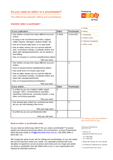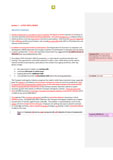
Do you need an editor or a proofreader? The differences between editing and proofreading
Prospective clients are often uncertain about the differences between editing and proofreading and which service they should be using. Editing and proofreading are two distinct and complementary phases within the publication production process (‘publication production’ being the process that takes the written word from the original writer to the public – or its intended audience – in any format).
Editing and proofreading are equally essential for business documents, reports, websites, marketing collateral, manuals and proposals – anything in written form that needs to clearly inform and impress its intended audience.
Editor or proofreader?
Use this checklist to help decide if you need an editor or a proofreader
What is editing?
‘Editing’ (by a professional editor/subeditor/copy editor) does the heavy lifting. Depending on the quality of the original material, it may involve:
- correcting grammar, spelling and punctuation
- imposing publication or company ‘style’ (e.g. how certain words are spelt, capitalisation, etc.)
- smoothing out patches of rough or poor writing
- replacing poor or incorrect word choices
- spotting and inserting missing words or words that are spelt correctly but are the wrong word (e.g. short words such as ‘of’, ‘is’, ‘a’ or ‘the’ may be missing, and words such as ‘of’, ‘if’, ‘is’ or ‘it’ may be used inappropriately)
- checking possible factual errors and noting queries for the writer
- reorganising the content sequence
- completely rewriting the material into publishable form
- rejecting the material as unsalvageable and unsuitable for use.
See an example of an edited article
This article has been edited in Word using ‘track changes’.
If the writing is of good quality, the editing may be light, with only a few changes here and there and other changes made for reasons of style (e.g. capitalisation). If the writing is poor, the tracked word-processing file will be a sea of coloured changes.
The editor is an excellent ‘wordsmith’, a good writer in their own right with an eye for detail who enjoys the order, clarity and correctness they can bring to the written word through their superior language skills.
Editing can be a time-intensive process, depending on the document length and quality, so enough time should be allowed before the scheduled release or publication date. If there are multiple documents or articles, a ‘flow’ should be established so the editor receives material progressively, rather than in one large lump close to the deadline.
For a single report or document, editing time depends on the length and quality of the original. The editor will want to go through the material carefully at least twice. The first edit will catch 90-95% of the changes needed, and the second edit allows the editor to double-check, confirm or change their earlier editing decisions, and have fresh eyes for anything they may have missed. Allow time before your deadline for the editor to get through their process and send the document back to you so you can check the tracked changes and attend to any queries.
What is proofreading?
‘Proofreading’ (by a proofreader) happens at some point after the editing is completed. Traditionally, in a publication such as a magazine, it comes after the articles have been laid into their pages by the graphic designer with any related photos, photo captions, tables and figures.
It can also be done in the word-processing file before layout to avoid having the graphic designer/IT professional making fiddly text changes and introducing new errors.
Proofreading is best done when the publication’s articles are in their pages with their photos, captions, tables and figures in place (or when a report has been formatted with its graphics and checked by relevant internal stakeholders). The proofreader then comes in as a dispassionate third party, who has not seen any of the material before, and reads it cold.
Assuming the article has been through editing, proofreading is an essential double-checking process. No editing is perfect; the more work an editor has done on an article, the greater the need to have it independently checked.
Proofreading should be a ‘light’ job, with the heavy work already done by the editor.
See an example of a proofread article
This article has been edited, laid out in InDesign, and then proofread.
The proofreader looks for what the editor has missed or perhaps got wrong:
- grammar, spelling and punctuation errors (particularly use of apostrophes as possessives and incorrect contractions)
- missing publication ‘style’ (e.g. capitalisation)
- any remaining rough/poor writing
- poor or incorrect word choices
- missing words and incorrect words that are spelt correctly
- possible factual errors
- editing ‘strays’ (e.g. sentences that end in the middle of nowhere, words that have been left in that should have been removed, or commas that should have been deleted when text was removed)
- wrong symbols
- use of hyphen, en dash and em dash
- consistency of writing tense
- use of singular and plural
- plus much more.
The proofreader now also has an overview of the report or article that the editor/subeditor may not have had, because they can see the accompanying photos, captions, tables and figures with the words in near-final format. Do the captions match the photos? Are the tables and figures referred to in the text? Do they make sense? Have the tables/figures been reproduced correctly? Are there any missing? Are the headings spelt correctly? Are there any problems in the overall layout?
The proofreader has an acute eye for detail, from the five-point text notes under the table to ensuring the correct spelling of the 72-point heading, plus everything in between. A good proofreader adds the polish that takes the report or publication from 85-90% to as close to 100% as possible in such a detail-oriented field.
Proofreading is quicker than editing, but slower than ordinary reading. Depending on the size and publication format (paper or electronic), text density and subject, allow between one to four weeks before the publication date for the proofreading and subsequent corrections required. For example, a 24-page A4 magazine/report might take 3-6 hours over 1-2 days and a 48-page A4 magazine/report might take 6-12 hours over 2-3 days.Turnaround time depends on the length, quality, density and difficulty of the subject matter.
Book an editor or a proofreader today
Do you need an editor/copy editor? Do you need a proofreader? To access skilled and trained professional editors and proofreaders, contact Professional Word Services today at [email protected], (03) 9583 5884 or 0418 532 114.
We charge the same hourly rate for editing and proofreading, so you can select the service that best meets your needs. Our specialist professionals have decades of experience across business and media and can shape and polish an article or publication that will reflect well on you or your organisation and impress its intended audience.



